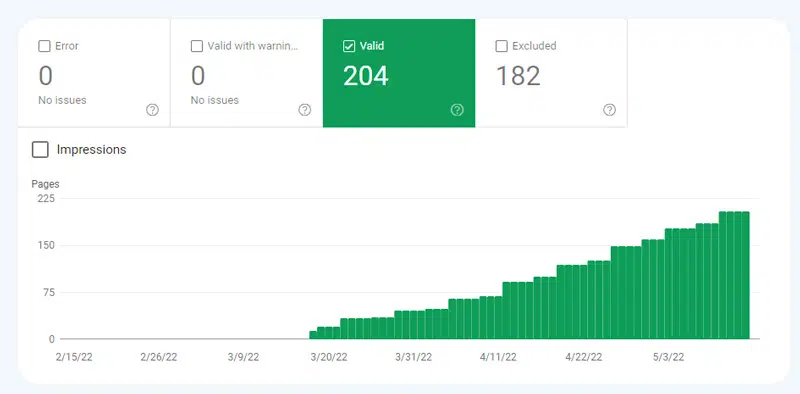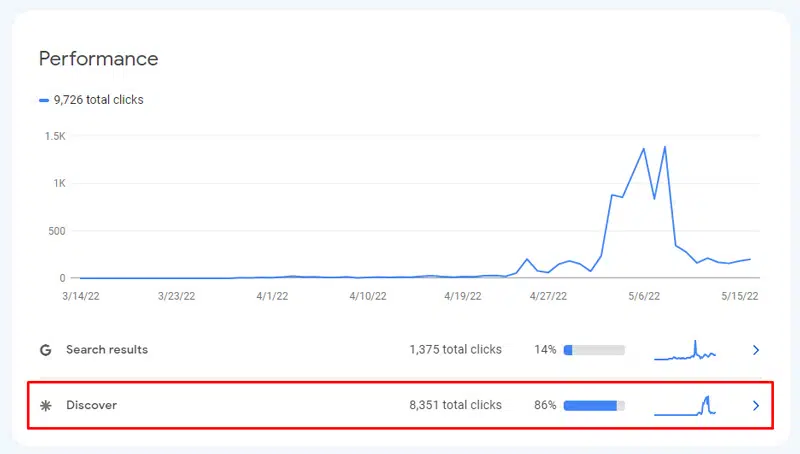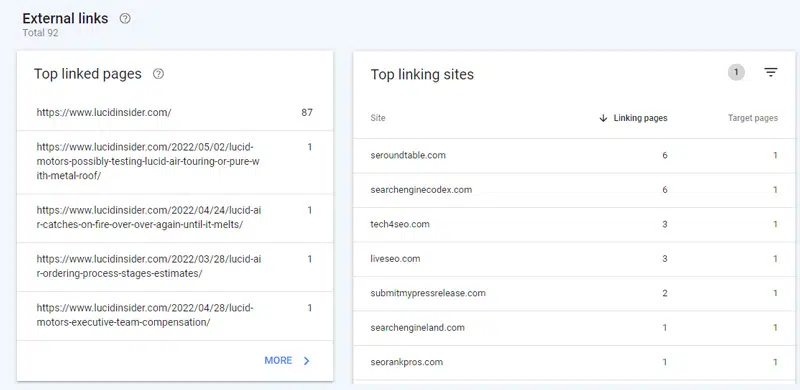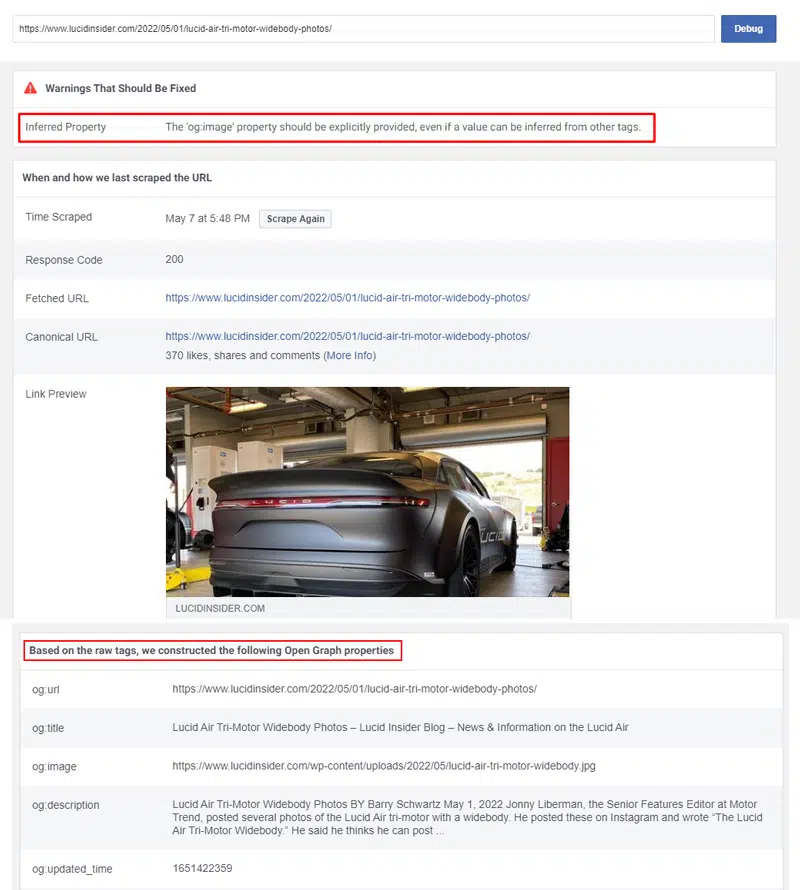Lucid visibility: How a publisher broke into Google Discover in less than 30 days from launch
Find out why, and how, it happened – and whether that Discover visibility will remain over the long-term, in this case study.
Google Discover is one of the most sought-after traffic sources by publishers. It’s also one of the most confusing from a visibility standpoint.
For many, it’s an enigma. Some publishers receive millions of clicks per month, while others receive absolutely none. And a ton of traffic can turn into no traffic in a flash, just like when a broad core update rolls out.
Google has explained that it’s looking for sites that “contain many pages that demonstrate expertise, authoritativeness, and trustworthiness (E-A-T)” when covering which content ranks in Discover. Strong E-A-T can take a long time to build up, or so you would think. For example, when a new site launches and has no history, no links, etc., it often can take a long time to cross the threshold where it can appear in Discover (and consistently).
That’s why the following case study is extremely interesting. I’ll cover a new site, run by a well-known person in the tech news space, and the site broke into Discover in a blistering four weeks from its launch. It is by far the quickest I have seen a new site start ranking in Discover.
And if you’re in the SEO industry, I’m sure you’ll get a kick out of who runs the site. It’s no other than Barry Schwartz, the driving force behind a lot of the news we consume in the SEO industry. But his new site has nothing to do with SEO, Search Engine Roundtable or Search Engine Land.
Or does it?
Let’s jump in.
Unrelenting writing and publishing
As many of you know, Barry’s work ethic is insanely strong. He’s written more than 30,000 articles about search. When he decides to do something, look out.
So as you can guess, Barry took his Search Engine Roundtable blogging process and employed that for Lucid Insider, his blog dedicated to news about Lucid Motors, a car manufacturer producing the luxury electric sedan Lucid Aid. He blogs every day, with multiple posts covering what’s going on in the Lucid World.
Over the past several days, I went through most of his posts (about 150) and I feel completely up-to-speed on Lucid. It’s sort of the way the SEO industry feels when reading Search Engine Roundtable. I bring this up just so you have an understanding of content production on Lucid Insider.
The first article was published on March 15, 2022. There are now 204 URLs indexed on the site.

Time To Discover Visibility (TTDV)
Haven’t heard of TTDV yet? That’s because I just made it up.
Lucid Insider started surfacing in Discover in just four weeks from the time the site launched. For the most part, that’s before any (consistent) strong signals could be built from an E-A-T standpoint, before earning many links, before publishing a ton of content on the topic, etc.
And since the first article broke into Discover, Lucid Insider has consistently appeared in the feed (both as articles and Web Stories). As of a few days ago, Discover has driven 8,351 clicks to the site out of 9,726 total clicks from Google. Traffic from Google Search is building but has only accounted for 14% of total clicks so far. Discover is now 86% of total clicks from Google.


Articles and Web Stories ranking in Discover
After Barry launched Lucid Insider, I pinged him and said he should build some Web Stories, especially as Discover showed signs of life for Lucid Insider. I have seen first-hand what Web Stories can do visibility-wise in search and Discover.
Specifically for Discover, Google has a Web Stories carousel, which prominently displays a number of stories in a special feed treatment. So, I thought Barry could create some stories to possibly rank there. And that definitely worked to an extent.
Both articles and Web Stories have ranked in Discover for Lucid Insider, although most of the Web Story traffic came from just one story. That story had a strong click-through rate of nearly 8%, but it’s really the only one that drove any substantial traffic.

Here is an example of that top Web Story from Lucid Insider appearing in Discover’s story carousel. The feed treatment is great and can drive a lot of impressions and clicks.

Google News: No visibility at all – until this week!
Since Discover is often tied closely to news publishers, you would think Lucid Insider would have also appeared in Google News – but that wasn’t the case. That was until this week, though!
The reporting didn’t even show up in Search Console for Google News until Monday. Sure, it’s not a lot of visibility yet, but this is a new website. So Google is expanding the visibility of Lucid Insider to Google News now and in just two months. Definitely a good sign for Barry.

It’s also worth noting that Barry doesn’t even have a Google Publisher Center account set up. That doesn’t impact visibility in Google News, but most publishers set one up, since you can control several aspects of your publisher account, including site sections, logo, etc.
Search is growing
Before I dig into the possibilities of why and how Lucid Insider broke into Discover so quickly, I wanted to touch on search. Although driving much lower traffic levels as a percentage of traffic, it is growing over time and will probably continue to do so.
Barry’s blog is starting to rank for a number of queries, and even has some featured snippets already. Google’s algorithms just need more time, in my opinion, which is at odds with Discover’s algorithms at this point.

So why, and how, is Lucid Insider ranking so quickly in Discover? Let’s explore the possible reasons.
E-A-T
I won’t go in-depth about E-A-T overall, since there are many other posts you can read about that. But it’s important to understand that Google explains in its Discover documentation that it looks for sites exhibiting high levels of E-A-T when determining what should appear in the feed.

It’s also important to understand that Google has explained E-A-T is heavily influenced by links and mentions from authoritative sites.
Therefore, I immediately jumped into the link profile of Lucid Insider. Again, it has only been publishing content since March 15.
When digging into the Links report in GSC, there were only 92 links there. And most of them were from SEO-related sites and content, and not automotive content.
That’s because Barry had mentioned his new blog on Search Engine Roundtable and Search Engine Land, and those sites get copied and scraped all the time, so those links end up on many other sites focused on search. I’m not saying those other sites are providing a ton of power or value link-wise, but it’s worth noting.

From an E-A-T standpoint, both Search Engine Roundtable and Search Engine Land are authoritative sites, but they don’t focus on Lucid Motors, electric cars, automotive news in general, etc. So it’s weird to think Google would provide a ton of value from those links over the long-term, because they aren’t topically relevant at all.
I bolded “over the long-term” because I have a feeling Google’s algorithms are still figuring things out for Lucid Insider. Longer-term, I’m not sure SEO-related links will help Lucid Insider as much, as Google’s algorithms determine more about the site, its content, focus, etc.
There are definitely a few links from Lucid forums to Lucid Insider, but not many yet… And check out Majestic’s topical trust flow, just to understand the topics Lucid Insider are associated with from an inbound links standpoint. The topics reflect an SEO blog and not a blog covering Lucid Air, at least for now.

Does your personal expertise / authoritativeness matter
For journalists, Google can connect the dots and understand articles published across sites. Google has explained this before in a blog post about journalists and you can see it firsthand in the SERPs. For example, Google can provide an Articles carousel in the SERPs for certain journalists.
So, is Barry being the author causing Lucid Insider to break into Discover faster than another author would? Could Google really be doing that?
I’m pretty sure that’s not the case. I’ll explain more below.
Barry has an Article carousel in the SERPs, but it only contains Search Engine Land and Search Engine Roundtable articles. Lucid Insider isn’t there. The carousel shows up when you surface Barry’s Knowledge Panel when searching for “Barry Schwartz technologist”.

In addition, Barry isn’t even using Article structured data (or any structured data) to feed Google important information about the article content, including author information. And he could be helping Google connect the dots by providing author information, including author.url, which is a property of Article structured data. That is what Google recommends providing, especially for journalists that write for various news publishers.
And when checking Barry’s Wikipedia page and Knowledge Panel, there is no mention of Lucid Insider. Barry should probably hop on that, but it’s not there as of now.
And last, even using a related query for Lucid Insider doesn’t yield any results (which would show you related sites to the domain you enter). Again, this will change over time as Google understands more about the site, the content, the focus, etc.

So, I doubt Google is making the connection there based on Barry being the author. Let’s move on.
Fresh topic + rabid fans = big opportunity
Lucid Air is a new electric car manufacturer, so there is clearly not as much written or covered as Tesla or other car manufacturers. That could definitely be playing an important factor with Lucid Insider’s visibility in Discover.
For example, there’s less content to choose from when selecting content to show in a user’s Discover feed, when that person shows an interest in Lucid.
To give some context, here is Google Trends data for interest in Lucid Motors compared to Tesla, Inc.

And here is Google Trends data showing interest in the various models (Lucid Air versus the Tesla 3 or S):

In addition, there are some serious Lucid fans out there. So those people are eager to check out news and information from various sources of Lucid information. And Discover is based on a person’s interests and activities, so travels across the Lucidsphere could be leading Discover’s algorithms to surface more Lucid information in their feed and maybe the algorithm is hungry for that information. And again, there isn’t as much content for Lucid as other topics, at least yet.
Here is the top Lucid forum showing some of the activity there. Also, check out the sidebar. There’s a familiar face there.

It will be interesting to see how Lucid Insider performs in Discover as more sources of information hit the web. I saw this first-hand with Web Stories in Discover.
When the carousel first launched, I was early to publish a Web Story. And it received 304K impressions in Discover. That wasn’t the case when I published subsequent stories, as more and more publishers started creating Web Stories. Anyway, we’ll see how it goes as more sites cover Lucid Air.

No structured data, no Open Graph tags
I mentioned earlier that Barry isn’t using any structured data at all for his articles. Well, he’s not using Open Graph tags either.
While Open Graph tags are not a ranking factor, they do provide more information about each article, including which images to use when shared. And Google Discover can use that larger image provided by Open Graph tags.
When checking the various social debugging tools, you can see that Facebook is dynamically populating open graph tags via other tags its finds on the page, the Twitter card validator bombs, etc.

I’m just providing this information to show that Barry has a relatively basic setup from a technical standpoint. And he’s ranking in Discover despite not providing all the bells and whistles.
Desktop-first indexing? What?
Google has explained in its developer documentation that mobile-first indexing will be enabled for all new sites starting in July of 2019. Well, for Lucid Insider desktop-first indexing is enabled. Just an interesting side note I discovered while digging into the data and reporting.

That said, the crawl stats show mostly smartphone crawling, so maybe Google Search Console lags for displaying the correct indexing model for Lucid Insider. Again, just an interesting find.

Broad core updates and Discover impact:
I mentioned earlier that Discover visibility can be impacted by broad core updates. I have covered that heavily in my blog posts about broad core updates, in presentations covering the topic, and on Twitter. Google’s John Mueller has explained this as well and it’s in the official blog post about broad core updates.

The reason I mention this is because Lucid Insider was launched in between broad core updates (and a fresh one hasn’t launched yet).
Could Lucid Insider be seeing a surge in Discover because Google doesn’t have enough signals yet to accurately measure site quality and relevance and a broad core update hasn’t been released? As Google’s quality algorithms are refreshed with the next broad core update, will Lucid Insider disappear from Discover?
It’s totally possible. Even Barry understands that what he’s experiencing is super-fast for breaking into Discover and now Google News.
Four weeks is nothing when some other sites are still not in Discover, years down the line. We’ll be watching closely as the next broad core update rolls out which will hopefully be soon. We are due, that’s for sure.
Also, John Mueller has explained in the past that some newer sites might rank very well in Search in the short-term until Google’s algorithms can pick up more signals about the site, content quality, relevance, etc. And once it does, then the site could drop, or even surge. So just like I explained above, Lucid Insider can potentially see volatility as Google picks up more signals, understands its place in the web ecosystem, etc.
Here is my tweet about that segment regarding Search. You can check out the video I linked to from the tweet (where Google’s John Mueller explains more about this):
Will Lucid Insider’s Discover visibility remain strong?
So there you have it. Lucid Insider broke into Discover extremely quickly and is driving a majority of the traffic to the site now. Search is increasing, but Discover is 86% of Google traffic as of now.
Although I covered a number of areas that could be helping Barry appear and thrive in Discover, this may be short-lived, at least until the site can publish much more content, earn stronger links and mentions from automotive sites, blogs, forums, etc., and build stronger E-A-T overall.
And in true Barry-form, he will be freely sharing how the site is performing over time across Google surfaces. So stay tuned for updates on how Lucid Insider is performing in Search, Discover, and Google News.
Contributing authors are invited to create content for Search Engine Land and are chosen for their expertise and contribution to the search community. Our contributors work under the oversight of the editorial staff and contributions are checked for quality and relevance to our readers. The opinions they express are their own.
Related stories
New on Search Engine Land